I was in Amsterdam for Queens Day. This is basically an excuse for Dutch people to dress in orange and jump up and down all day to boshing Eurodance, on the streets and on the canals, couched in the pretext of monarchical patriotism.
Here are some orange people, jumping up and down to boshing Eurodance on a boat. There was a lot of this.
This was a special Queens Day, as it also featured the abdication of Queen Beatrix, monarch since 1980, in favour of her son Willem-Alexander. Dutch royals roll differently from our lot, and abdications are their usual way of doing things. At the last abdication, the outgoing Queen Juliana is supposed to have collapsed in sobs (or so I was told; can’t be arsed to fact-check), but no such dramas ensued this time round, at the really rather dull abdication ceremony. There was however a goodly amount of rapid blinking, suggestive of some sort of emotion, from the incoming King and his glamorous Argentinian consort Maxima, who had worked her way through three costume changes by teatime.
After the really rather dull abdication ceremony, there was an almost as dull inauguration ceremony, in which a crown was laid out for the new King, but never actually placed on his head. A humble bunch, your House of Orange. Prince Charles was in attendance, as he had been in 1980. He sees them come and he sees them go. How galling that must be.
My host for the long weekend was Alan, who some of you might remember as Reluctant Nomad. Alan gave up blogging in 2007, shortly after being voted South Africa’s best gay blogger, which was pretty good going for an ex-pat. Perhaps he felt his work was complete.
On the morning of Queens Day, we visited the newly re-opened Rijksmuseum, where we spotted this Dutch Renaissance dude checking his Twitter.
But I digress. You came here expecting a post about pizza, so let’s plough on.
“What would you like to do while you’re here?” Alan asked me on my first day. “There are several museums that we could…”
“I’d like to eat pizza. It’s for a very important commission.”
Alan suggested that we stretch the remit of National Pizza Week, by eating a Turkish pizza called Lahmacun. This is served in a restaurant called Bazar, on Albert Cuypstraat. The street also has a large open-air market, which might account for Bazar’s unusual architecture. Inside, it looked like an old corn exchange building: high-ceilinged, with an all-encompassing upstairs gallery that overlooked the ground floor.
Update: It’s actually a converted synagogue. My thanks to Alan for his research.
We sat upstairs, beneath an amazing tiled wall that stretched all the way up to the vaults. You’ll see a bit of this wall further down, but before you do, take a look at the wall on the opposite side.
Please note the following points of interest.
a) What does that inscription say? Is it in Hebrew? I’m not good with alphabets.
Update: Alan and Sevitz have confirmed that this is Hebrew. A literal translation: “Eating together is a friendship lubricant”. As Alan says:
I can only assume that it’s a recent addtion and not a remnant from the restaurant’s synagogue past.
b) What is that door for, way up at the top of the building, with its little balcony? Its function eluded us.
c) The illuminated green glass is actually the top of a massive dumb waiter, which connects the upper and lower kitchens. Again, its function was called into question, as all dishes were manually carried upstairs on gigantic metal platters.
My Lahmacun was listed on the “Lunch Dishes” section of the English menu and the “Small Dishes” section of the Dutch menu, so I ordered it as a starter. Any worries that I’d podge out before the main course were obliterated by the slow service, the forty-five minute gap between my Lahmacun and my Yogurtlu Adana giving me ample time to rebuild an appetite. Perhaps the staff had thoughtfully factored this in. Well, that’s the charitable explanation.
Here is my Lahmacun. I was going to order it with the optional extra of cheese, but forgot.
It doesn’t look much like a pizza, does it?
Once opened, its pizza-ness does become more apparent. Its closet cousin is probably the calzone, which is also served folded.
The filling consists of minced veal, which I wouldn’t normally order, but there were no alternative fillings. The yoghurt dip was an awkward presence, as it had too much of a cooling effect on the already lukewarm dish. I used it sparingly. Meanwhile, a side salad provided the sensation of cheese.
I’m no food critic, so suffice it to say that I enjoyed my Lahmacun. Look at the lovely tiles!
Afiyet olsun! (That’s “bon appetit” in Turkish.)


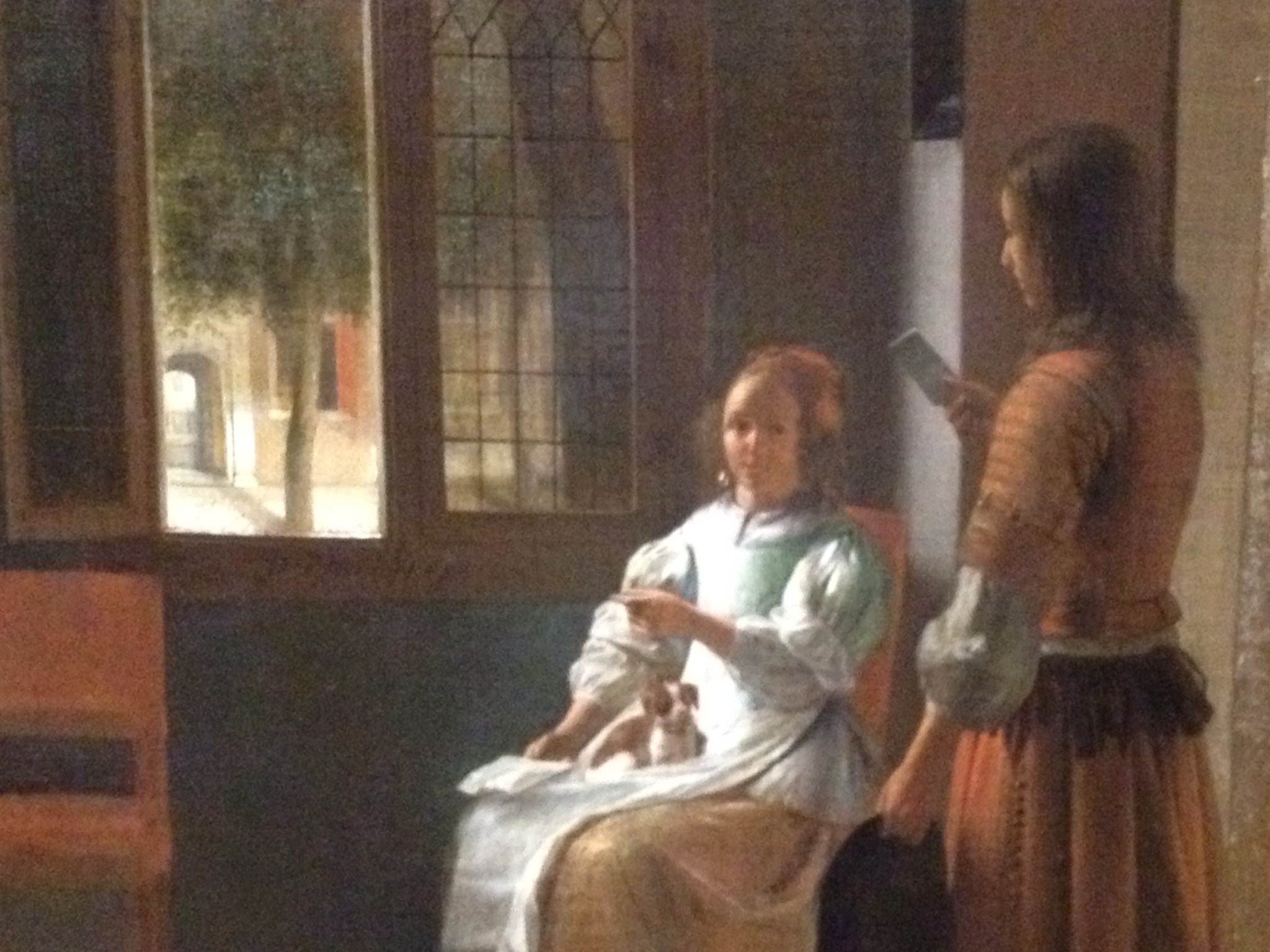
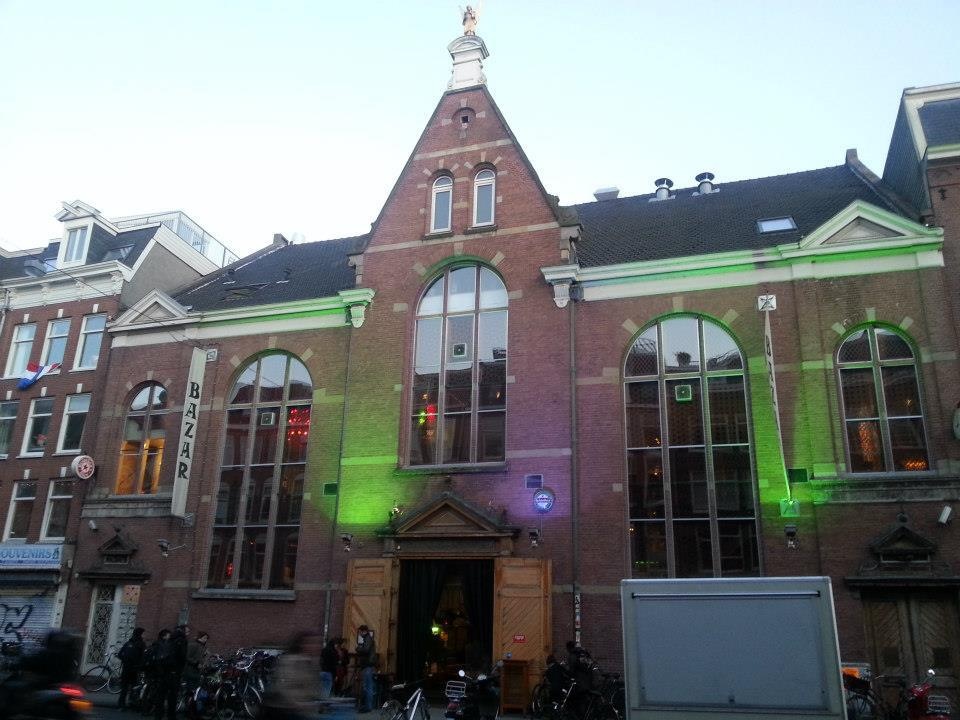
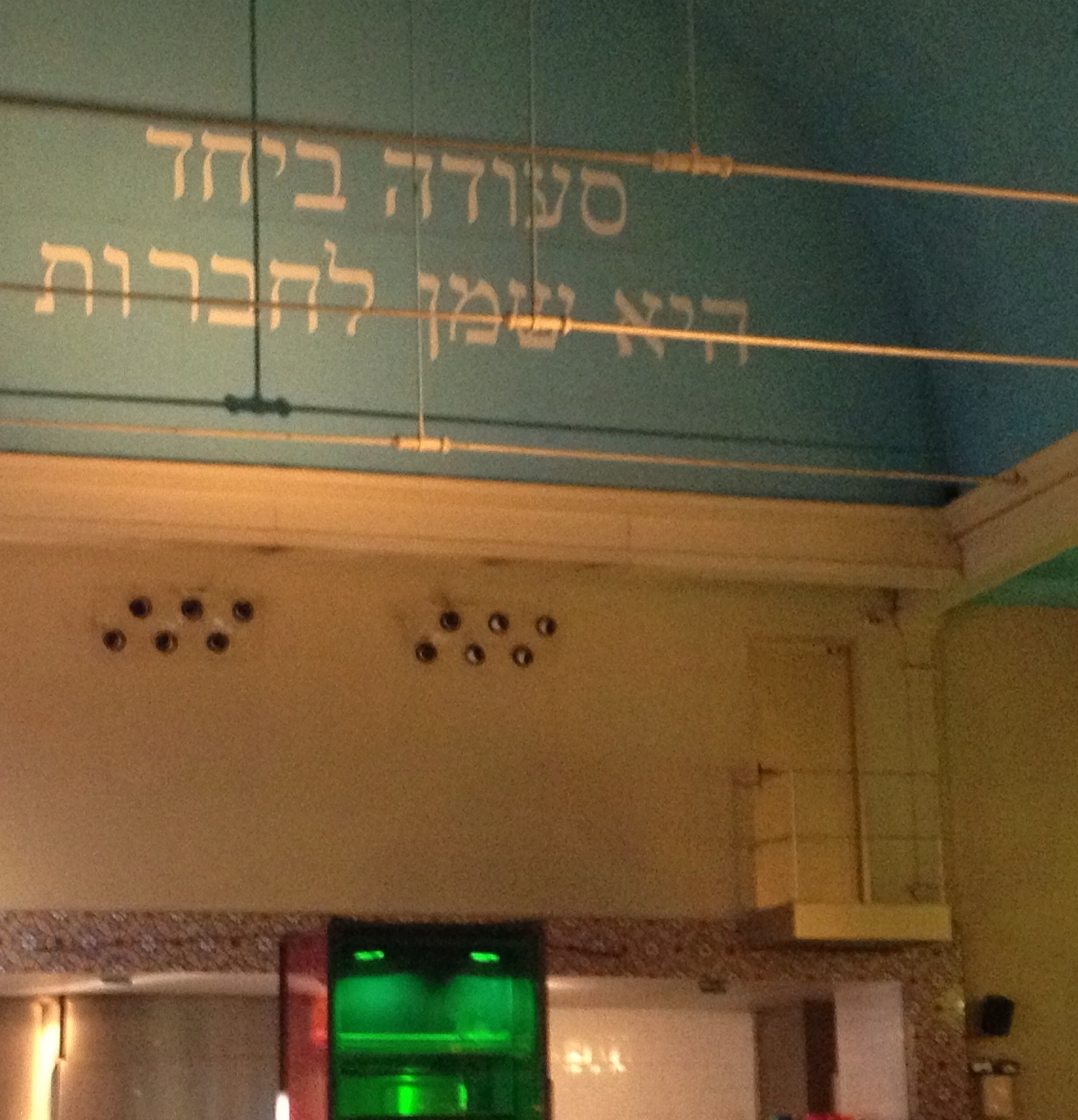

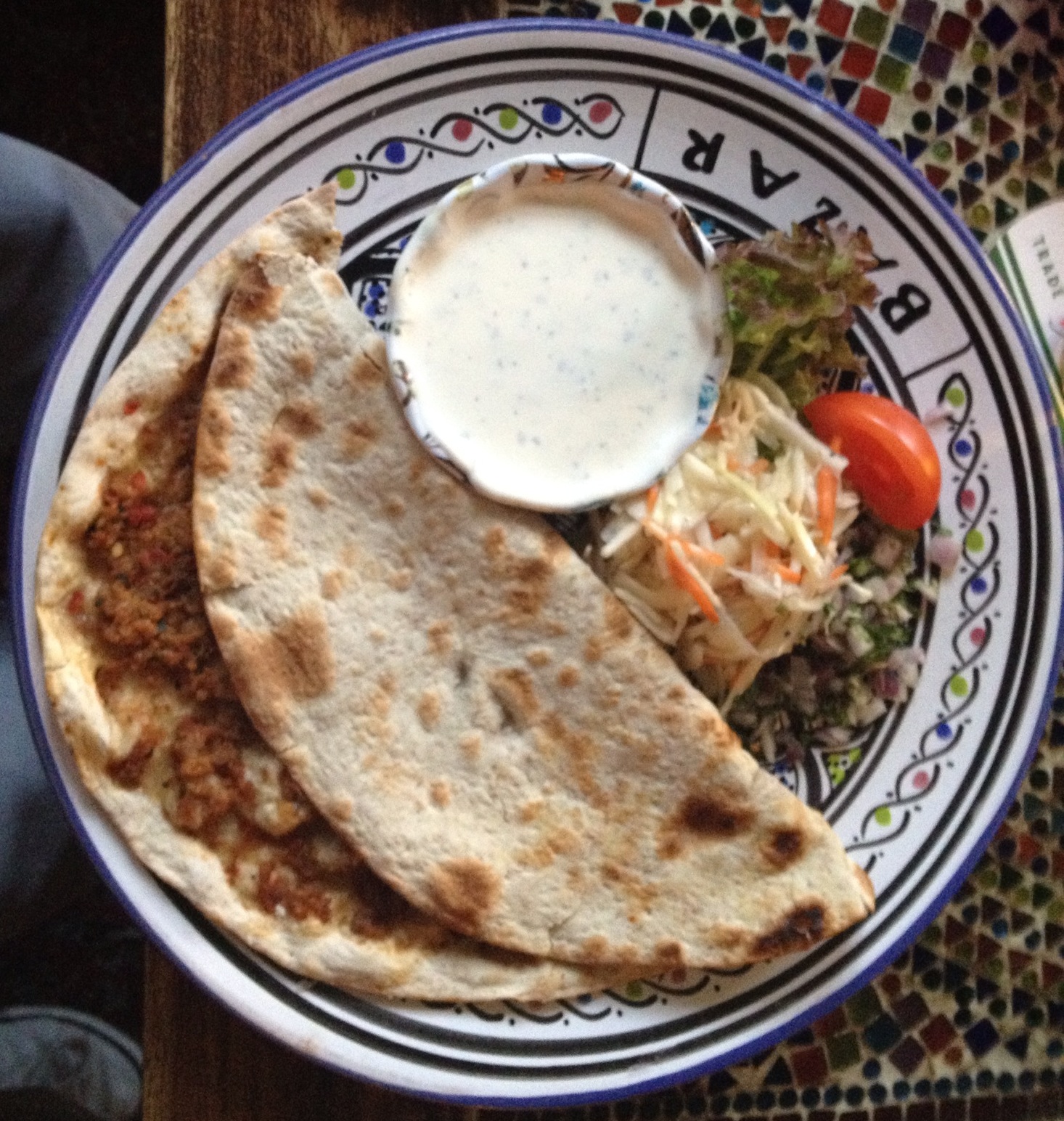

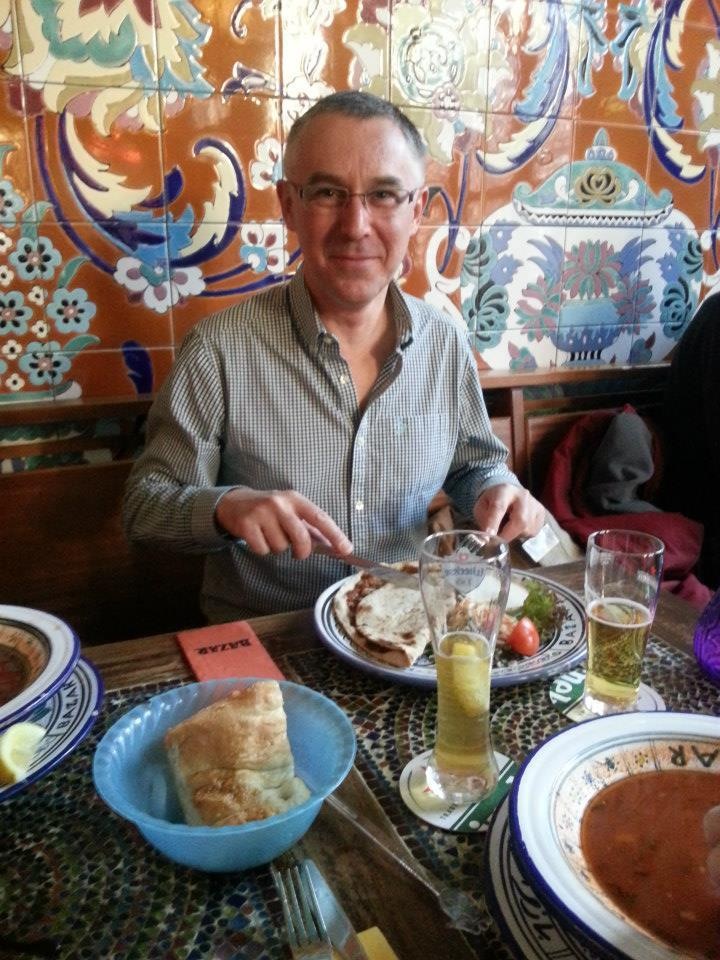
Side salad? On a pizza? No. Sorry, just… no.
It’s unnatural, I tell ya.
The Hebrew literally means
“Eating together is a friendship lubricant”
(the last word sorta means oil/lubricant so can mean fuel)
So it’s saying “Eating together is fuel for friendship” or could mean “Eating together is a social lubricant”
(I asked a friend to do the translation, so can’t give much more help than that)
National Pizza Week has been thoroughly international.
A Dutch friend has left this remark on Facebook:
“Sounds like a typically Dutch dining experience. (slow, luke warm)”
I couldn’t possibly comment.
The service was very mediocre, even by Amsterdam standards.
A bit of research tells me that the inscription is indeed Hebrew – the restaurant is a converted synagogue! Apparently, the inscription translates into something like “a meal together is the oil of friendship”. I can only assume that it’s a recent addtion and not a remnant from the restaurant’s synagogue past.
Hooray for friendship lubricants!
Hooray for oily friendships!
Mike, this was such a fantastic little sojourn into Turkey by way of Holland, thank you for eating the cheese-abdicated vealcalzone so that we didn’t have to.
And! I love this oily international internet friendship that we’ve been lubricating liberally with pizza! AFIYET OLSUN everyone!
Brilliant! Thanks Mike!
This is why Uborka was created, I’m sure.
Having eaten extensively in the Netherlands, service is often slow but sometimes fast. They do tend to cook things rather than re-heat them, which is a good thing. EVERYTHING comes with a side salad, even salad, but the side salads are rarely any good and are usually just boring leaves with too much dressing.
One thing to note about Dutch eating-out – every settlement with more than about 1000 people will have a Greek restaurant. They are possibly even more common in the Netherlands than Indian restaurants are in the UK. This has always struck me as odd – in most major towns in the UK, you’ll bump into people from the subcontinent on the street. The British have a long (and not always glorious) connection with the subcontinent. I can understand why we have so many Indian eating places. But what’s the connection between the Netherlands and Greece? And where are all the Greeks on the streets of Amsterdam, Leiden, Utrecht…? Can anyone cast any light?
I can’t say that I’ve noticed how ubiquitous Greek restaurants are here in the Netherlands but I don’t many Dutch settlements besides Amsterdam, Utrecht, Leiden and den Haag. However, I have often wondered why there are so many Argentinian steakhouses in Amsterdam.
Oh yes, that too! And, in the one or two I’ve been to, the steak wasn’t that good either. But it did come with a side salad.